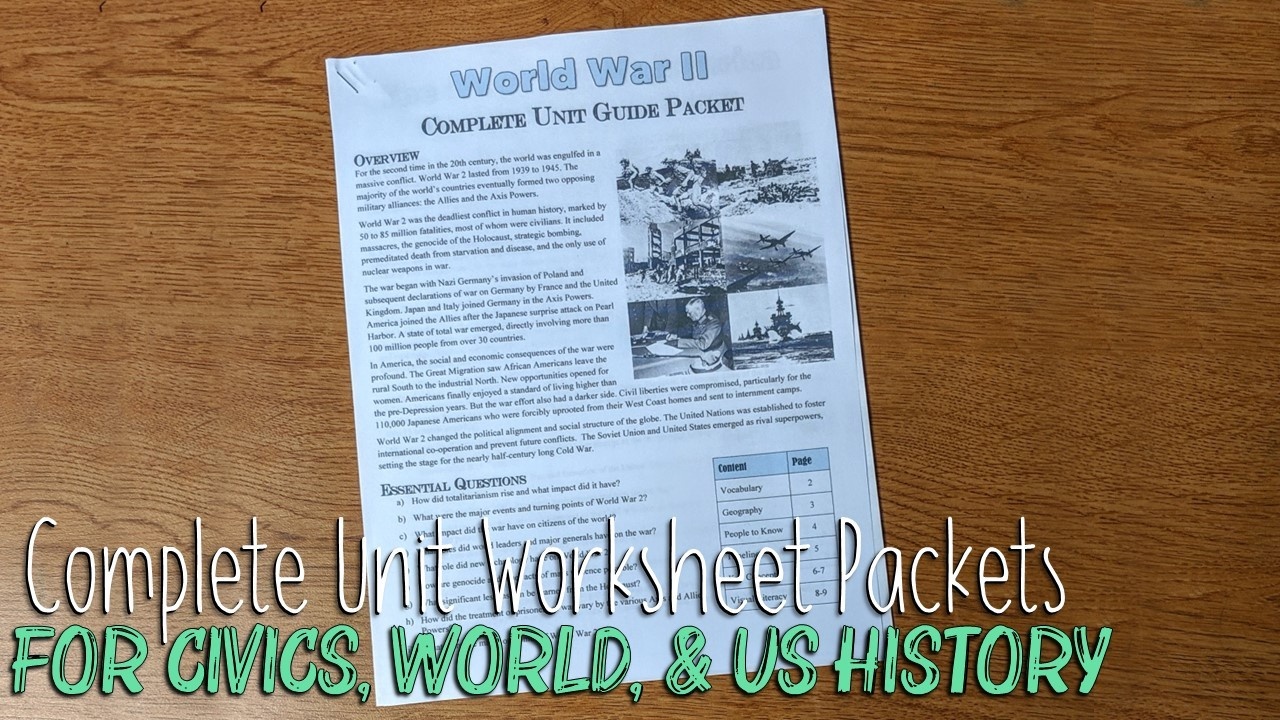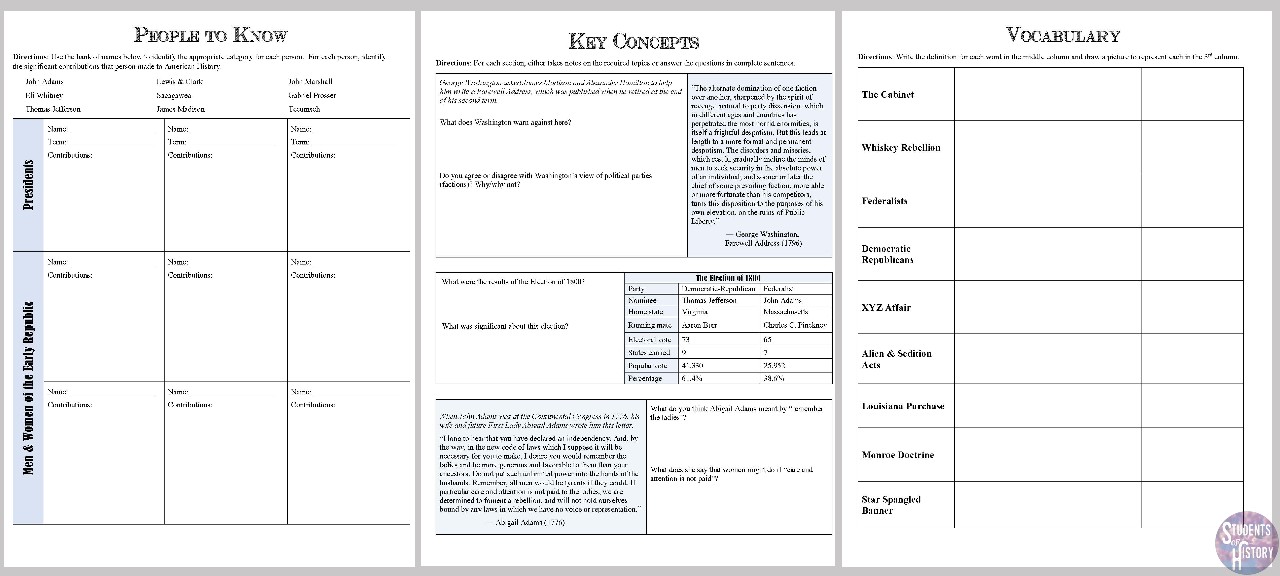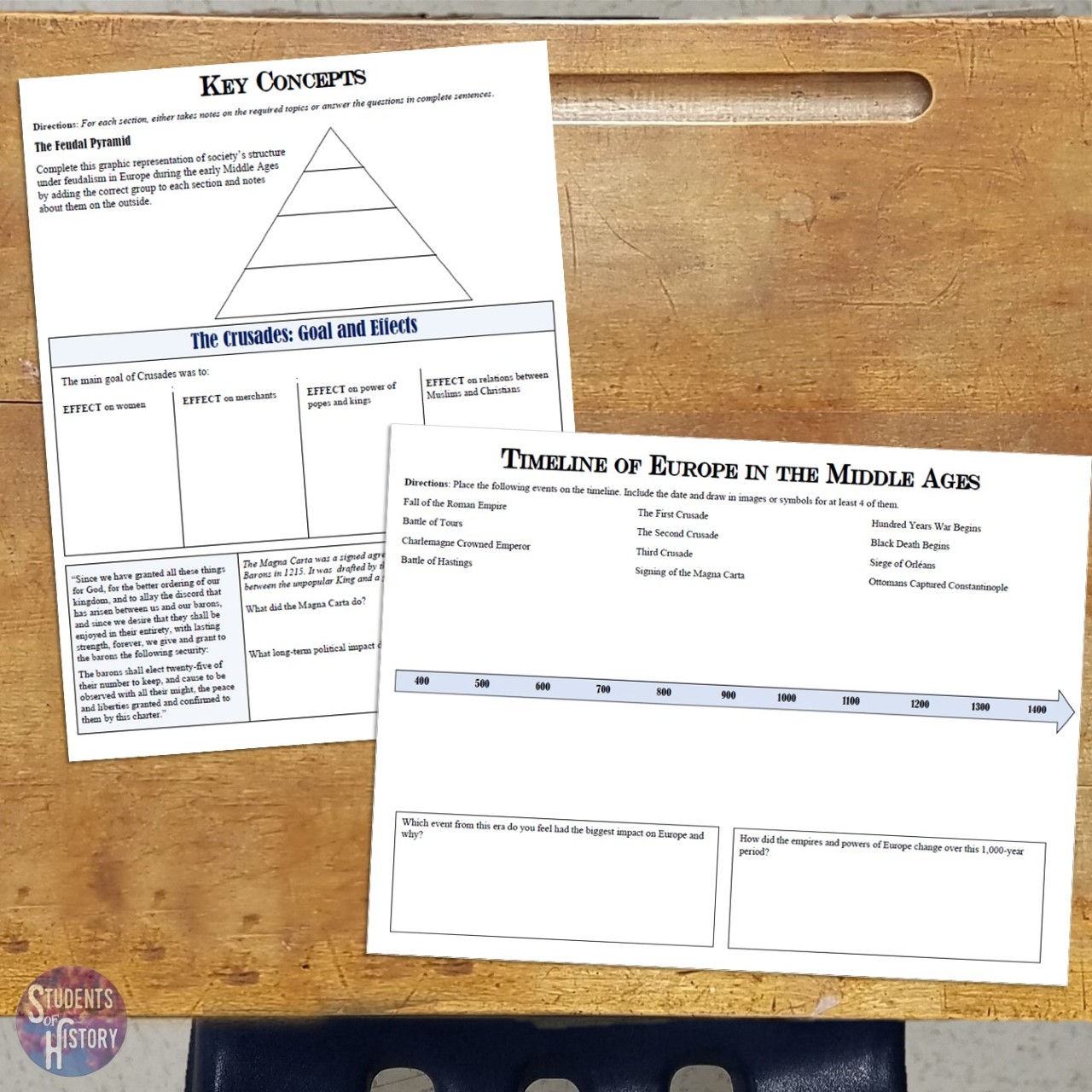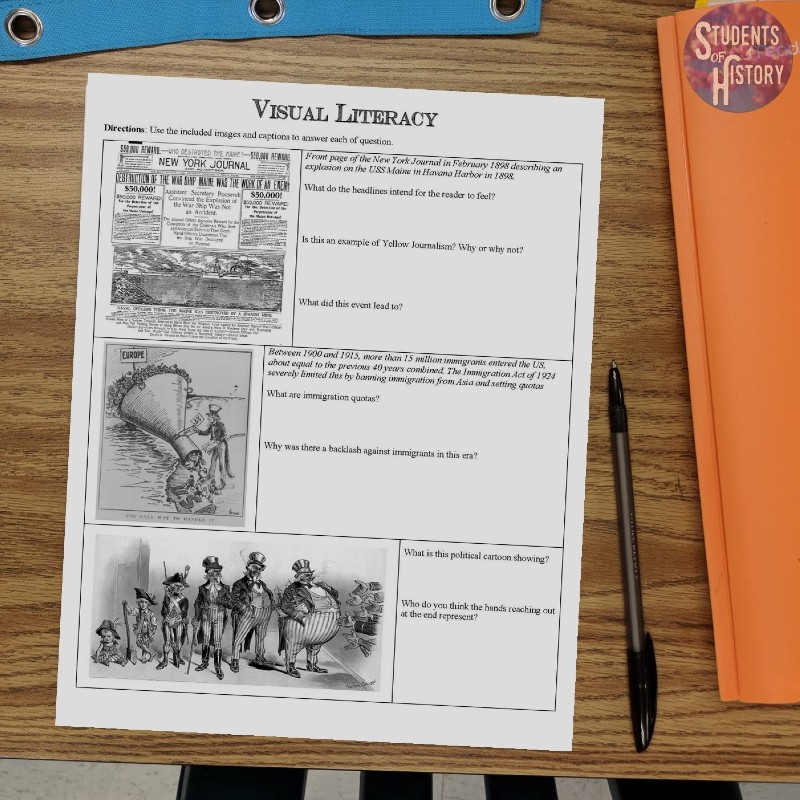Worksheet Packets for Civics, World, & US History

One of the most time and energy-saving strategies I started using in my social studies classroom was to employ unit guide packets for students.
These thorough 9-page packets were a huge help in a few ways:
- Printing the majority of student work at once each unit instead of each day.
- Students know exactly what they need to know for the test and have it in one place.
- If I'm ever out sick, students can just work on their packets.
They took a long while to create, but I now have packets for every unit in Civics/Government, World History, and US History. That's 48 total packets and over 400 pages of student worksheets!
Each one features an introductory reading, standards-based Essential Questions to guide the unit, and then 9 pages dedicated to vocabulary, geography, people, timelines, key concepts, and image analysis.

Here's a closer look at what's included on every page:
Unit Introduction
This page features a short reading on the unit that introduces students to the key events, people, and things to know. There's always an eye-catching image as well as a set of standards-based Essential Questions to guide your teaching of the unit.

Vocabulary
Page two in each packet features the most important vocab terms your students will need to know for that unit. These vary from between 9-15 terms depending on the unit. The page has students define each word in the middle column (in their own words, of course) and then add a picture in the last column. For the printable PDF option, students draw a simple image. In the Google Doc option, students can search for and insert and image.
Geography
The next page in the packet is a map activity to help students' geography skills and to better understand the location of cities, countries, battles, or major events from the unit. This will vary by unit and subject, but often has students coloring territory, placing cities or trade routes in their correct location, or identifying key landmarks or geographic features of an area.
Again, this page is slightly different in the PDF versus the Google Doc. Since drawing and coloring areas is difficult to do on a digital Google Doc, I provide students with a completed map image and have them respond to analysis questions based on it. I don't like it as much as them actually physically working on the maps like they can do on paper, but it's the best option I have found if you are fully digital.
People to Know
This page usually features 9 people or groups that students need to know for that unit. Whenever possible, I like to have students categorize them to add an extra dimension to the activity. For example, with my Civil War Unit Packet, students are presented with the following 9 people:
Abraham Lincoln, Clara Barton. Frederick Douglass, Harriet Beecher Stowe, Jefferson Davis, Robert E. Lee, Robert Gould Shaw, Thomas “Stonewall” Jackson, & Ulysses S. Grant
They first have to place each into the correct category of either a Political Leader, General, or Civilian During Wartime. Then, they identify their title and briefly summarize their contributions to history.
Timeline
The timeline page is a great one for students to better understand this important social studies skill. It usually includes 12 major events from that era that students have to place in the correct location along the timeline. They also are required to draw in a symbol or picture for at least 4 of them. I add that requirement just to ensure they spend a little more time on it and ensure they're not blatantly copying from another student. Everyone should have the events in the same location, but no students should have the same pictures/symbols as another student.
There's also a couple analysis questions at the bottom of the page to help students understand or reflect upon the events from the timeline. They might have to explain which they think had the biggest impact on the era or interpret the length of time between certain events.

In the Middle Ages Unit Packet above, you can see the timeline activity with questions and also the Key Concepts page in which students identify the feudal pyramid, describe the effects of the Crusades, and analyze a primary source excerpt.
Key Concepts
This 2-page section features primary source and secondary source excerpts for students to analyze in addition to charts and other activities to help students understand the most important aspects of the unit. These pages might have students complete a Venn Diagram, compare one or more sources to another, or complete a cause and effect chart.
I often select the most prominent primary sources I have from the unit and excerpt them down to a small paragraph here. Then, there will be a couple short answer reflection or analysis questions to go along with each one.
For the Google Doc option, I also include links here to more in-depth readings, videos, or helpful content that is available online.
Visual Literacy
The last section of the unit packet is a 2-page set of images, maps, and other visuals for students to analyze. Each image is accompanied by a short introduction or caption and then 1-3 questions for students to complete.
For example, in the Progressive Era and Imperialism page below, students analyze a newspaper headline related to the Spanish-American War, and political cartoons related to immigration and imperialism: 
Strategies and Tips for Use
I provide students the complete packet when they complete their assessment from the previous unit. As they wait for everyone to finish their test, they read the introductory page and can start working on the packet if they like.
Then, anytime we have an extra few minutes over the course of the unit, I instruct students to work on their packet. This is super helpful if you often find yourself with 5 extra minutes before the bell. They can also work on it at home and there is the expectation that it must be finished before the unit test.
The day before our unit test, I have students take out their packet and will help them with any sections that gave them difficulty.
Another option is to break it up and give to students one page at a time. This is especially helpful for students who might be overwhelmed with the full 9-page packet at once.
This also works well if you have some students in class who will finish it all in one night while others will need all the time you can allow.
I also like to provide students with the printed packet to complete but post the Google Doc version to Google Classroom. This way, if any student loses it, they can print their own at home or complete the digital version and submit it online.
Every unit guide packet for Civics/Government, World History, and US History also includes a complete answer key for your convenience in addition to the editable Google Doc option.
They're available in the bundles linked above or individually (I included direct links to all of them at the bottom of this post). You can also access all of them for any subject through a curriculum subscription.
Do you have any questions about using these in your classroom? Or have you used them already in a different way? Please let me know! I'd love to hear from you.
US History Unit Packets
- Exploration & American Indians
- The 13 Colonies
- The American Revolution
- The Constitution
- Early America
- The Age of Jackson
- Sectionalism & Manifest Destiny
- The Civil War
- Reconstruction
- The Gilded Age
- The Progressive Era & Imperialism
- World War 1
- The Roaring 20's
- The Great Depression
- World War 2
- The Cold War
- The Civil Rights Movement
- Modern America
World History Unit Packets
- Prehistory
- River Valley Civilizations
- Ancient Greece
- Ancient Rome
- Islamic Civilizations
- Classical Asia
- The Middle Ages
- Mesoamerica and African Civilizations
- The Renaissance
- The Protestant Reformation
- Age of Exploration
- Absolutism in Europe
- The Age of Enlightenment
- French Revolution and Nationalism
- The Industrial Revolution
- Imperialism
- World War 1 and the Interwar Era
- World War 2
- The Cold War and Decolonization
Civics and American Government Unit Packets
- Unit 1: Introduction to Government
- Unit 2: Foundations of American Government
- Unit 3: The Constitution
- Unit 4: Political Parties & Ideology
- Unit 5: Campaigns & Elections
- Unit 6: The Legislative Branch
- Unit 7: The Executive Branch
- Unit 8: The Judicial Branch
- Unit 9: Civil Liberties
- Unit 10: Foreign Policy
- Unit 11: State & Local Government
Want to try some lessons for free?
Try out some free lesson plans and resources for your social studies classroom!
Don't worry, your information is never shared.